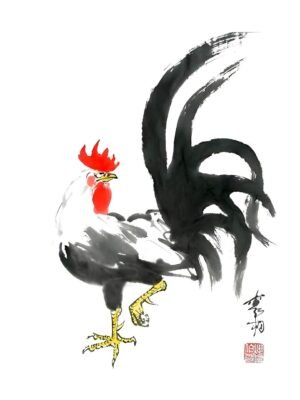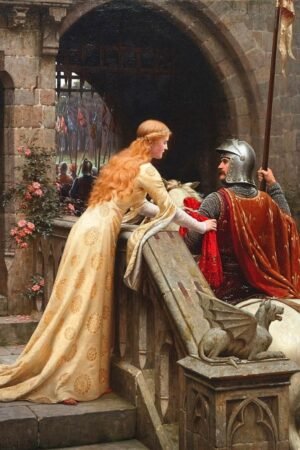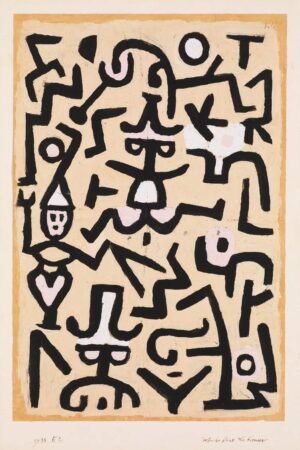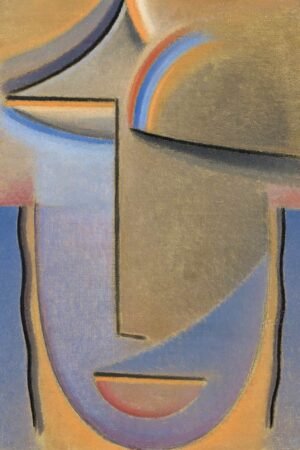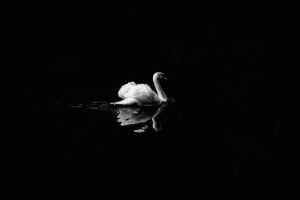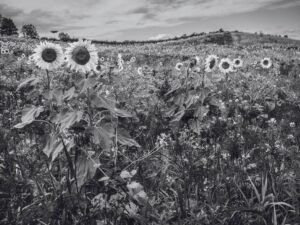Claude Monet is, of course, a very celebrated name in art history. He is most closely associated with the movement of Impressionism, which aimed to capture fleeting moments in the world.
His enormous, beautiful paintings of delicate lilypads, summer gardens, and dreamy water reflections are famous for their shifting light and unique depiction of color. In addition to his serene scenes of nature, he also made paintings depicting Parisian city life and portraits of people, illustrating the diversity of Impressionism.
Now, nearly 150 years after Impressionism’s heyday, it remains a remarkably recognizable and loved art form. And, by following some of the basic tenants and remembering the philosophies of the Impressionists, you can learn to paint like them and create beautiful compositions of the world around you.
About Claude Monet and Impressionism
What makes the Monet painting technique so special? To answer this, let’s look at Impressionism overall— it’s worth knowing a little bit about the Impressionist art movement and its context in history.
Impressionism was founded in the 1860s in Paris by Claude Monet, Edgar Degas, Camille Pissarro, and others. Their approach differed from other painters of the time in that they hoped to capture the fleeting moments in nature—they went about this by sitting outside (en plein air) and quickly painting the scene before them, with an emphasis on how the light shifts on nature’s shapes. They might’ve spent several sessions in the same place, but each session tended to be short. Most other artists of the time only painted in their studios.
The first group exhibition of Impressionists was in Paris in 1874 and included Monet. One of his works displayed, Impression, Sunrise was mocked by critics—its title was used as a way to insult it. To them, it was a silly and incomplete impression, not a legitimate painting and definitely not a masterpiece. In addition, the bright colors of Impressionism departed from the more somber shades of a popular academic painting of the time.
Despite initial rejection by the art world, Impressionism emerged as the prominent style in Paris by the 1870s and 1880s. Fast forward to today, Claude Monet has been the subject of hundreds of exhibitions posthumously and his work continues to achieve very high prices at auction.
How to Paint Like Monet: A Look at a Typical Impressionist’s Technique
Before we get into specifically how to paint like Monet, let’s look at some of the Impressionists’ general techniques, themes, and trends. Here are a few general ideas to keep in mind regarding the overall approach of artists in the Impressionist school:
- They focused on the optical effects of light. They didn’t dwell on realism, but rather the effects that light can have on things in the world. They were interested in the vibrations that can be made through color, not technicalities of space and mass.
- They often used short dashes of paint to form strokes, which was intended to form the essence of the object as opposed to the exact detail of every part of the object.
- Impressionists employed generally lighter palette.
- Most Impressionists often avoided hard edges by working with wet-on-wet paint. Objects tend to fade into each other subtly, and definite edges were used sparingly.
- Unlike the thin glazes of Renaissance painters, Impressionists used thick paint to create an opaque surface throughout the composition. This is called impasto. This takes Impressionism even further from ideas of realism.
- They painted at a time of day with long shadows to more accurately catch dramatic light.
- The use of broken color is central to their technique. This means they optically blended colors, rather than on the palette. For example, they might stipple colors on top of other colors to achieve an effect, rather than blending it smoothly on the canvas. This is a specific way they achieved the optical effects of light that we mentioned above.
- They used complementary colors next to each other to achieve heightened vibrancy and contrast.
Supplies You’ll Need to Paint Like Monet
- Oil paint. You can use acrylic paint and still try and mimic Monet’s process, but if you truly want to paint like Monet, gather some oil paint tubes (acrylic paint wasn’t invented for 80 years after Impressionism).
- Oil paint medium, such as turpentine.
- A palette. Anything can do—but again, master Impressionists would’ve used a wooden hand-held palette. You could also use a plate of glass or a plastic palette.
- A primed canvas or panel.
- Paintbrushes. The Impressionists used hog bristle brushes, which allowed for the thick application of paint which they liked, but nowadays there are a lot more options than animal hair brushes. You can opt for synthetic brushes to achieve similar effects. Gather a few different sizes to create variety in brushstrokes—Monet used several different sizes and shapes himself. You can see this when you closely look at his work.
- Optional: an easel! Especially if you want to paint en plein air, you should come up with some sort of stand to hold your canvas and supplies. That way you have the mobility and a comfortable way to work.
- Optional: a palette knife. This helps you create some of the rougher strokes to give the composition spontaneity and abstract feel.
Before you get started, let us reiterate our six main pillars of Monet’s painting techniques. Keep them in mind as you work!
- Apply paint thickly—build it up over time.
- Use complementary colors. A good way to go about this is looking at a color wheel and looking at colors opposite of each other. For example, yellow and purple are complementary colors.
- Mix color as you apply it to the canvas, rather than on the palette beforehand.
- Keep it bright. Impressionists made light and airy works, especially Monet.
- As you work, you might find that squinting is helpful. Squinting makes you look at things out of focus, and in a way, this is was Monet was doing when he overlooked specific details of the scene before him. Shadows and highlights stand out to you as detail of shapes gets lost.
Step-By-Step: How to Paint Like Monet
So, you want to make an Impressionist masterpiece by following the Monet painting technique? We’ve put together some overarching steps to follow—this isn’t a step-by-step painting with pictures of a specific scene, but rather foundational steps to approach your unique composition with.
Additionally, while Monet painted quickly in terms of how much he put on the canvas in an hour, he did it over several sessions in order to let the oil paint dry. However, you can consolidate into one session if you wish, especially if you opt to use acrylic paint.
Pick Your Spot Outside!
Many of Monet’s paintings were made at his home in Giverny, near Paris, which remains a popular destination for travelers today. Works of nature were most often painted at Giverny—so, to get started, find your own Giverny for inspiration.
Pick a nice day and move outside for your painting. You’ll find a lot of tutorials of how to paint like Monet, but when you think about it, that’s not actually painting like him if you’re painting inside and copying a work. As we mentioned, he painted outside for a reason! So head outside and find a scene that you hope you hope to paint. If you can’t go outside, try to find a window with a nice view.
Remember, Monet painted with an emphasis on light—so keep that in mind when you’re finding your spot. Maybe you can paint early or late in the day to achieve the same long shadows that he did.
This is a bit more conceptual, but remind yourself of the goals of the Impressionists: to capture the fleeting appearance of nature. Take a moment to immerse yourself in your setting. Even if it’s not quite as serene as Monet’s garden at Giverny, try to focus on the beauty of the nature before you. We’ll end this step on a quote by Monet:
“The richness I achieve comes from nature, the source of my inspiration.” –Monet
Prepare Your Palette
Before you start, get some colors down on your palette. There isn’t really a right or wrong way to do this, but remember Monet’s frequent use of complementary colors, and make sure you have white in your palette to vary the tints. Try to avoid black—even shadows have colors.
If you want to adopt a color palette like Monet did in many of his outdoor paintings, such as Water Lilies, you can put the following colors on your palette:
- Cobalt Blue
- Cadmium Yellow
- Alizeron Crimson
- Ultramarine Blue
- Brilliant Rose
- Emerald Green
- Hooker’s Green
- Titanium White
But any colors will do. Again, you canadapt this to acrylic paint, but Monet used oil paint.
Make a Loose Pencil Sketch
Let’s get started with a known Monet painting technique. He often started his paintings with a loose sketch of the composition. Using a pencil, try your best to block out some outlines of the shapes in front of you. This doesn’t make anything totally set in stone though! You can of course adjust the composition a bit as you go.
You’re trying to capture the feeling of the scene before you, not copying it, so don’t get too caught up on photorealism. Just block out the major components: a horizon line, a water line, a tree shape, or a fence line, for example. Think of them as a framework as you fill in colors in the next step.
This is best expressed through the words of Monet himself:
“When you go out to paint, try to forget what objects you have before you, a tree, a house, a field or whatever. Merely think here is a little square of blue, here an oblong of pink, here a streak of yellow, and paint it just as it looks to you, the exact color and shape.” –Monet
Fill in Large Color Blocks
Start filling in blocks of color according to your light pencil lines—just go for it! Start broad. Don’t worry about exactly matching the color of what you’re looking at. As we mentioned earlier, squinting is a good tool for this. Fill in the blues of the sky and water and the greens of the grass, for example.
Remember that you don’t have to paint it all at once, so don’t feel the need to get everything in right away. Monet himself tended to start more vague before narrowing in on smaller shapes of the painting. So, we will go back in to add smaller marks later.
Tip: A common Monet painting technique was crosshatching, which created a subtle yet vibrant texture. Rather than making every brushstroke the same, he created lines which crossed over each other to form dimension. So, in your painting, use horizontal and vertical strokes to indicate how light bounces every which way in the world. Look closely at one of his paintings to identify this Monet painting technique.
Keep Adding Color and Develop the Contrast
This step is a continuation of filling in color. Start adding in smaller shapes. Don’t be scared to put yellows next to blues—putting different colors side by side just creates optical effects that the Impressionists were so fond of. Use a variety of brushes to make the whole composition vibrate as you learn how to paint like Monet.
As far as color goes, Monet relied on emerald green to form the bright foliage in nature. Pink, as a complementary color, goes great right next to it. Perhaps if you’re adding leaves to trees, lilypads to water, or other interruptions on planes of green, you could use pink to do so.
This is the step where you add smaller marks—fill in the leaves of trees, add small highlights in bodies of water, and anything else to complete the work.
Focus on Gradual Transitions
This isn’t exactly a step, per se, but something to start paying more attention to as you continue to add details. By focusing on how you treat transitions between colors and shapes, you can affect the final painting dramatically. This is a more technical aspect of learning how to paint like Monet.
The softer the edges, the more volume and ambiguity there is on the surface of the painting. The tighter the edge is, the more definite and concrete something appear. So, if there’s something sitting on the surface of the water or flying in the sky, you’ll want to create those objects with slightly more abrupt edges, whereas the water or sky will be a hazy blend.
Let’s look at this in terms of Monet’s painting specifically. He primarily used gradual transitions in his work with a smattering of abrupt edges. A good example is the edge of the water lilies on ponds in his paintings.
Keep this aspect of the painting in mind as you add detail. Trust your intution of what you’re looking at—if you feel that there is a large block hazy block for part of the composition and a definite stroke for a specific flower, follow your gut, and translate it onto the canvas.
Add Final Touches, But Don’t Overthink It.. and here’s how to paint like Monet!
Easier said than done, but as you finish up the painting, remember where the term Impressionism comes from—the feeling that the painting is an spontaneous impression. Not a rigid, calculated, and totally realistic depiction of nature, but a fleeting perception of something.
Therefore, don’t overthink what you have on the canvas. Resist the urge to fill in every last detail. Just reflect on the overall feeling of where you are sitting, step away, and enjoy the fact that you’ve frozen a moment in time.
The beautiful thing about the Monet painting technique is that it can be repeated so differently each time. He was experimental, and the way the world looked in front of him impacted what he put down on the canvas. He made so many scenes of nature based off his instincts, and you can too. If you’re not satisfied with your first try, give it another go.
Additionally, the ideas of Impressionism go beyond nature. If the Monet painting technique resonated with you, feel free to venture into more man-made areas.
Hopefully, this article gave you some insight into the painting process of one of the most famous artists in the world. Of course, you can’t recreate the mind of Monet, but you can follow his philosophies when creating your own work—that is really the best way to learn how to paint like Monet.
Discover Our Latest Art Prints
Explore the latest additions to our curated art collection, designed to inspire every room.
-

Chinese Rooster Art Print
Price range: $23.00 through $139.00 This product has multiple variants. The options may be chosen on the product page -

God Speed Art Print by Edmund Blair Leighton
Price range: $23.00 through $209.00 This product has multiple variants. The options may be chosen on the product page -

Paul Klee Comedians Handbill Abstract Art Print
Price range: $23.00 through $209.00 This product has multiple variants. The options may be chosen on the product page -

Abstract Head of woman, Evening Print Alexej von Jawlensky
Price range: $23.00 through $209.00 This product has multiple variants. The options may be chosen on the product page -

White Swan Floating on Dark Water Wall Art Print
Price range: $23.00 through $209.00 This product has multiple variants. The options may be chosen on the product page -

Black and White Sunflower Field Wall Art Print
Price range: $23.00 through $209.00 This product has multiple variants. The options may be chosen on the product page


